Like Walking into a Fairy Tale or Back into Medieval
Europe
Maramures, Romania
by Sarah Shuckburgh
Sarah Shuckburgh travels
through space and time to an ancient Romanian way of life.
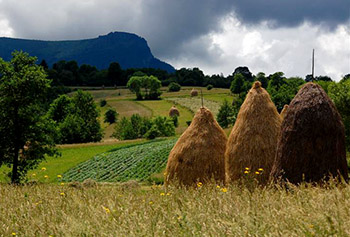 I
wake to the sound of crowing, clanking and mooing. As
chickens peck in the dust just beneath my window, a dozen
cows are shuffling through the village, their bells a
hollow, discordant jangle. At each house, another cow joins
the throng. Like a dog-walker or childminder, one villager
is taking his neighbours’ cows off for a day’s grazing. I
wake to the sound of crowing, clanking and mooing. As
chickens peck in the dust just beneath my window, a dozen
cows are shuffling through the village, their bells a
hollow, discordant jangle. At each house, another cow joins
the throng. Like a dog-walker or childminder, one villager
is taking his neighbours’ cows off for a day’s grazing.
This is the village of Hoteni in Maramureş, one of the
remotest corners of the European Union, where villagers have
preserved a way of life which most Europeans cast off
centuries ago. Too far from Bucharest to have had its
identity crushed by Ceauşescu, this isolated part of Romania
has clung on to its ancient rural heritage and to its
unspoilt landscape of pastures and forests. Visiting
Maramureş is an extraordinary experience, like walking into
a fairytale or stepping back into medieval Europe -
life-affirming and restorative, but also evoking poignant
feelings of regret for what we have lost.
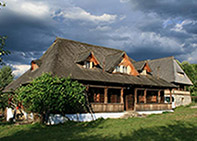  Hoteni nestles between hillsides of poplar, beech and
flowering ash. Beyond, lie snow-covered Carpathian peaks and
spruce forests where bears and wolves still roam. Here, in
the Land of Wood, traditional houses are made of timber,
with steep shingled roofs, dovetail joints, wooden pegs and
no nails. Gates are massive, perhaps 12 feet high, topped by
a shingle roof, and with intricate wood-carvings of ropes,
suns and wolves’ teeth – to protect the family from harm.
Every household has its own well, neatly hoed rows of
vegetables and colourful pots and pans dangling from a tree,
a local custom which began as a practical way to store
cooking utensils in a home with no cupboards. Hoteni nestles between hillsides of poplar, beech and
flowering ash. Beyond, lie snow-covered Carpathian peaks and
spruce forests where bears and wolves still roam. Here, in
the Land of Wood, traditional houses are made of timber,
with steep shingled roofs, dovetail joints, wooden pegs and
no nails. Gates are massive, perhaps 12 feet high, topped by
a shingle roof, and with intricate wood-carvings of ropes,
suns and wolves’ teeth – to protect the family from harm.
Every household has its own well, neatly hoed rows of
vegetables and colourful pots and pans dangling from a tree,
a local custom which began as a practical way to store
cooking utensils in a home with no cupboards.
 I am staying in a traditional Maramureş house. Although my
hosts married decades ago, the wife’s trousseau is
prominently displayed – layers of hand-woven blankets and
embroidered linen hang from the ceiling on wooden poles. By
a ceramic stove, a bed is heaped with more blankets and
cushions. Above the dining table, sacred icons are draped
with white scarves. I am staying in a traditional Maramureş house. Although my
hosts married decades ago, the wife’s trousseau is
prominently displayed – layers of hand-woven blankets and
embroidered linen hang from the ceiling on wooden poles. By
a ceramic stove, a bed is heaped with more blankets and
cushions. Above the dining table, sacred icons are draped
with white scarves.
Romanian villagers still use horse-drawn carts,
coffin-shaped with rubber wheels. I watch as a husband and
wife lug a wooden wagon into the road, harness their horse
with a bridle hung with lucky red tassels, and then,
perching on a plank balanced across the cart, bump off
towards their field.
 Following a stony track, I stroll to the neighbouring
village of Breb. It is a magical walk – silent except for
crickets chirruping, birds singing and hens clucking.
Everywhere, wild flowers grow with irrepressible exuberance
– a glorious, waist-high tangle, unchecked by chemical
sprays, filling verges, hay meadows, and Following a stony track, I stroll to the neighbouring
village of Breb. It is a magical walk – silent except for
crickets chirruping, birds singing and hens clucking.
Everywhere, wild flowers grow with irrepressible exuberance
– a glorious, waist-high tangle, unchecked by chemical
sprays, filling verges, hay meadows, and
 orchards of plum,
apple and morello cherry. orchards of plum,
apple and morello cherry.
This is the haymaking season. In Maramureş hay is still made
by hand, cut with scythes, turned using homemade wooden
pitchforks, draped over wooden railings to dry, and formed
into lanky haystacks around timber posts. Whole families are
at work - men scything with rhythmic swings, stopping to
sharpen blades on a whetstone; women and children tossing
hay. Several times, I have to step into the bank of
cow-parsley and dog-roses as a cart passes, its sloping
sides hidden by a tower of hay.
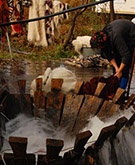 Breb is a maze of dirt tracks, with enormous carved gates
leading to small wooden houses, two of them restored by the
Mihail Eminescu Trust which Prince Charles supports. As I
walk through tall buttercups into a farmyard, a woman in
gathered skirt and headscarf is preparing food above an open
fire. Chickens peck about and tethered dogs leap towards me,
eagerly. A young girl looks up from the well where she is
drawing water. Her sister is washing clothes in a shallow
bowl. They speak a few words of French. Breb is a maze of dirt tracks, with enormous carved gates
leading to small wooden houses, two of them restored by the
Mihail Eminescu Trust which Prince Charles supports. As I
walk through tall buttercups into a farmyard, a woman in
gathered skirt and headscarf is preparing food above an open
fire. Chickens peck about and tethered dogs leap towards me,
eagerly. A young girl looks up from the well where she is
drawing water. Her sister is washing clothes in a shallow
bowl. They speak a few words of French.
 In an open-sided barn their grandfather sits, an old
woodcarver surrounded by half-completed headstones, babies’
cribs, decorated spoons, cups, and crucifixes – all made
from interlocking pieces of wood, with no nails. Pointing to
some tattered diplomas, he sighs that in the good old days
of Ceauşescu, the state valued folk-craft and woodcarvers
were well-paid, but no longer. In an open-sided barn their grandfather sits, an old
woodcarver surrounded by half-completed headstones, babies’
cribs, decorated spoons, cups, and crucifixes – all made
from interlocking pieces of wood, with no nails. Pointing to
some tattered diplomas, he sighs that in the good old days
of Ceauşescu, the state valued folk-craft and woodcarvers
were well-paid, but no longer.
In nearby Sârbi, a gushing stream has been ingeniously
channelled to provide a water-powered thresher, a washing
machine which tumbles clothes in a churning pool, and a
thumping device in which heavy beams pummel hot, wet sheep’s
wool into felt for coats, waistcoats and blankets. Several
men, dressed in thick felt trousers, wide belts and tiny
funnel-shaped hats with ribbons, are sitting by the
watermill drinking plum brandy.
 This isn’t the threshing season or the felt-pummelling
season, but it is the distilling season. At the village
still, a woman works on her crotchet while her plums are
turned into brandy. Three men tend the fire, turn a handle
to stop the mixture sticking, and, most importantly, sample
the ţuică dripping into a bucket. For stronger, purer
horinca, the distilling process will be repeated. Another
man is carving tiny plum-wood ladders to fit into bottles.
When brandy is added, the swollen wood turns the alcohol
golden, and adds a plummy flavour. This isn’t the threshing season or the felt-pummelling
season, but it is the distilling season. At the village
still, a woman works on her crotchet while her plums are
turned into brandy. Three men tend the fire, turn a handle
to stop the mixture sticking, and, most importantly, sample
the ţuică dripping into a bucket. For stronger, purer
horinca, the distilling process will be repeated. Another
man is carving tiny plum-wood ladders to fit into bottles.
When brandy is added, the swollen wood turns the alcohol
golden, and adds a plummy flavour.
Religion is hugely important here. There are nearly a
hundred wooden churches in Maramureş, eight of them UNESCO
World Heritage Sites. The village of Ieud, in the beautiful
Iza valley, has a 14th-century church made of fir-wood, with
a traditional spindly, shingled spire. Inside, the wooden
walls are decorated with 17th-century paintings, a mix of
Byzantine and folk art with biblical quotations in Cyrillic
script. At the altar, villagers are praying, crossing
themselves repeatedly, touching icons and kissing the carpet
beneath them. Outside, the gravestones are wreathed in wild
flowers.
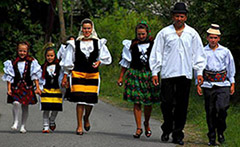 Nearby is a charming folk museum – an old house crammed with
handmade wooden implements. The custodian is a gold-toothed
woman in traditional gathered skirt, white blouse and
headscarf. She shows me how hemp is harvested, soaked in the
river, beaten with wood, carded, spun, washed, and wound on
to spools for weaving. A photograph of her winter wedding in
1972 shows bride and groom in bulky felt and sheepskin
clothes, homemade outfits which are now in the museum. Nearby is a charming folk museum – an old house crammed with
handmade wooden implements. The custodian is a gold-toothed
woman in traditional gathered skirt, white blouse and
headscarf. She shows me how hemp is harvested, soaked in the
river, beaten with wood, carded, spun, washed, and wound on
to spools for weaving. A photograph of her winter wedding in
1972 shows bride and groom in bulky felt and sheepskin
clothes, homemade outfits which are now in the museum.
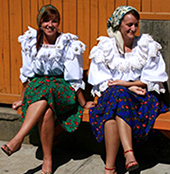 Returning to Hoteni, I watch the cows plodding back from
their grazing. In June, they will move to mountain pastures
for the summer, with a cowherd to make each day’s milk into
soft white cheese, and to guard the cattle from bears and
wolves. But this evening, each cow turns into its own yard,
as the villagers sit chatting on benches outside their high
wooden gates. Returning to Hoteni, I watch the cows plodding back from
their grazing. In June, they will move to mountain pastures
for the summer, with a cowherd to make each day’s milk into
soft white cheese, and to guard the cattle from bears and
wolves. But this evening, each cow turns into its own yard,
as the villagers sit chatting on benches outside their high
wooden gates.
The next day is Sunday, a day of rest from haymaking. As I
leave, the road throngs with villagers, many in traditional
costume, walking to church. Friendly voices call “Drum bun”
- good journey. A young man waves to me as he polishes his
shiny Chrysler. He tells me that he spent $4000 shipping the
car from America for just three weeks, to show his family.
He hopes soon, as further proof of his success abroad, to be
able to demolish his parents’ old wooden house and carved
gates, and replace them with plastic and concrete.
Life is hard for these villagers. Many younger Romanians are
keen to escape what they feel is a backward rural life. Many
older villagers mourn the loss of collective farms and
guaranteed wages. Eigh teen years after the overthrow of Ceauşescu’s regime, Romanians still have a corrupt,
inefficient government. Healthcare, sanitation and education
are chronically under-funded. Human rights violations
continue, including the notorious orphanages where children
are written off as mentally ill. The Roma gypsies are a
poorly-educated and despised underclass, under-represented
in government. Factories, mines and workers’ accommodation
blocks lie derelict - thousands of jobs disappeared after
the revolution, and the unemployed now eke out a subsistence
living from strips of land, unable to sell produce because
of exacting EU laws. teen years after the overthrow of Ceauşescu’s regime, Romanians still have a corrupt,
inefficient government. Healthcare, sanitation and education
are chronically under-funded. Human rights violations
continue, including the notorious orphanages where children
are written off as mentally ill. The Roma gypsies are a
poorly-educated and despised underclass, under-represented
in government. Factories, mines and workers’ accommodation
blocks lie derelict - thousands of jobs disappeared after
the revolution, and the unemployed now eke out a subsistence
living from strips of land, unable to sell produce because
of exacting EU laws.
But despite poverty and physical hardship, this remarkable
region has maintained qualities which have been lost forever
elsewhere in Europe. Maramureş was too remote to be invaded
by the Romans who gave Romania its name, and since antiquity
has proudly maintained its unique culture. I shall never
forget my visit - the wild flowers and birdsong, haymaking
and horses and carts, festivals and faith, woodcarving and
other crafts, evoking a time when life was hard, but also
calmer, simpler, slower, richer.
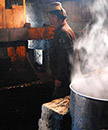
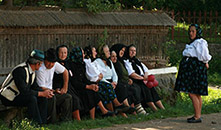
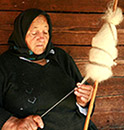

Photographs by Ramona Cazacu.
First published by the Telegraph
©SarahShuckburgh |